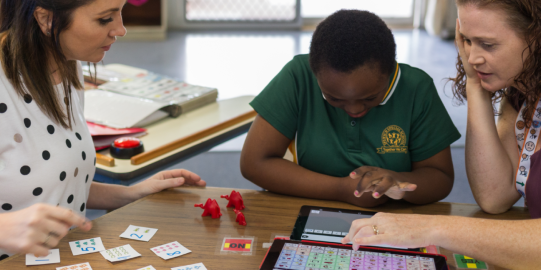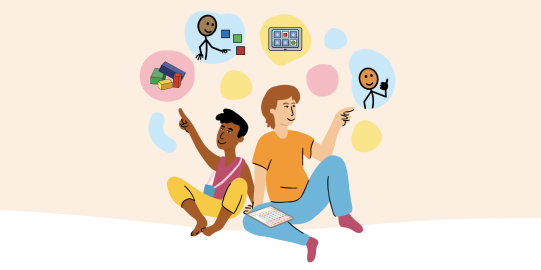Augmentative and Alternative Communication (AAC) requires teamwork. Building a strong, collaborative, and supportive AAC team is crucial for successful AAC implementation.
What is an AAC team?
An AAC team is a group of people who surround an AAC user. This group works together to plan, support, review, and reflect on how AAC is used.
Who is part of the AAC team?
The AAC user is at the team’s center, and those who surround them can be part of the team. Some members of the team could include
- Family and friends of the AAC user
- Speech-Language Pathologists (SLPs)
- AAC Specialists
- Teachers of the AAC user
- Medical professionals
- Other therapists, such as Occupational Therapists, Physiotherapists
The AAC team work together to make decisions about AAC user, including assessment and implementation. The team can work together to implement support strategies and troubleshoot when things aren’t going well.
Why should I make an AAC team?
AAC takes work. We know getting started and even keeping the momentum going can be challenging. Can a family do this alone with their child? Could a teacher do it alone with a student? Could the AAC user themselves undertake everything solo? Yes, but think of the possibilities if everyone around the AAC user was actively working together.
The more people around an AAC user that know and use AAC, the more opportunities they have to communicate. Someone can learn to use AAC quicker if AAC use is supported in more places they go. If someone can use AAC to communicate with everyone in their life, AAC becomes more meaningful and valuable. AAC teams working together can make this happen.
When should I make an AAC team?
Start now! AAC teams can start working together to support a person no matter where they are on their AAC journey! A great place to start is scheduling a meeting time for everyone on the team. Keep in mind that this can be an ongoing process. Each time a new member joins the team, take the time to meet and consider how you can best work together.
What are some ways an AAC team works together?
1. Making AAC always available
Team members can work together to set up the environment so AAC is available everywhere and all the time. They ensure the AAC system is always turned on, charged, and easy to access. This may also involve team members creating paper-based boards and posters of the AAC system. Team members can use straps, harnesses, and mounts to make the devices more portable and easy to access.
2. Getting and providing support and training
Teams need support. Teams may require additional training so that all members can have a shared understanding of AAC and AAC teaching methods. Developing a shared understanding will help them to maintain momentum and keep moving forward in the AAC journey.
Some team members may come in with more experience or background knowledge. They can lead in providing support and training to other team members.
All teams are different. They may need support and training in other areas. Look at our Learn AAC Guide to identify what areas of AAC members of your AAC team might need help.
3. Collecting information
Teams can collect information and examples of AAC in action. Ensure your team looks at what is and isn’t working for the AAC user. A good strategy is collecting videos, photos, and stories of successes and situations that need troubleshooting. These can be very useful to share within teams for support and training opportunities.
4. Reviewing and reflecting
Use your observations about how AAC is going to review and reflect on progress and current goals. Teams need to come together regularly to look at the information that has been collected. Take the time to recognize what isn’t working and what could improve. And always take time to celebrate your successes as a team!
Read our team collaboration series to learn more about AAC team collaboration:
- Understand the importance of AAC users within the team.
- How to face some of the common problems AAC teams experience.
- Consider the parent’s perspective, including how important it is for a parent to preserve the parent-child bond.
- Think about how Speech Pathologists can work within the AAC team.
- Listen to how teachers collaborate within AAC teams.
- How to get organized for AAC team meetings.
Links & References
- Copley, J., & Ziviani, J. (2007). Use of a team-based approach to assistive technology assessment and planning for children with multiple disabilities: a pilot study. Assistive Technology, 19, 109-125.
- Romski, M., & Sevcik, R. A. (2005). Augmentative communication and early intervention: Myths and Realities. Infants and Young Children, 18, 174–185.
- Samperi, Amanda. (2019). How I Do it: Teaching the AAC helpers. [Blog post]
- Zangari, Carole. (2017). On AAC Training: Skill Building for AAC Team Members. [Blog post]
- Zangari, Carole. (2013). 5 Things to Consider About Data Collection in AAC. [Blog post]





